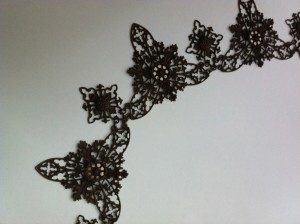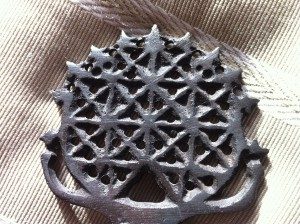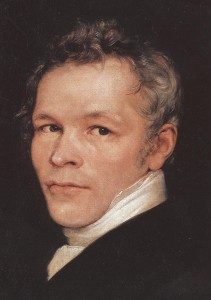Striking Delicate black jewellery with floral motifs in bracelets, necklaces, brooches, diadems, and earrings, made of … iron! Berlin Iron was the fashion that launched in Berlin – and prevailed throughout the rest of the world – between the late eighteenth and the nineteenth century.

Example of jewellery in iron
It is difficult today to think of iron as a precious metal for high quality jewellery. This metal is known in modern jewellery, but it is more of an exception than the rule. And yet, at important auctions, the authentic jewels of the “fer de Berlin“ reach astronomical prices.
I want to unveil a style of jewellery, not well known in our time, but one that has left an indelible mark in history. It all starts with iron foundries created in Prussia to become independent of Swedish iron production. This happened in the second half of the 1700s. The creativity of designers and the idea of offering diversified jewellery that was in accordance with the flourishing bourgeoisie of the time, gave rise to a totally new and particular style: iron jewellery, which was later known in All the world with its denomination in French: “Fer de Berlin”.

Jewels made of iron
The simplicity of the material, its dark colour and its roughness represented the virtues that the Prussian bourgeoisie of the time retained as indispensable: stability, discretion and moderation.
This coincided with a significant historical moment. Napoleonic troops had conquered great territories of Europe. Prussia had been invaded, and in 1806 Berlin had fallen into the hands of its conquerors, its foundations had been ransacked, and Napoleon had brought various models of iron jewellery to France to initiate production there. A period of stagnation seized the extensive regions of Prussia including the jewellery industry.

Karl Friedrich Schinkel
Prussia reacted from 1813 with the wars of liberation against France prompting Princess Marianne of Prussia to appeal to all Prussian women to donate their jewels.
In return they would be given a ring or an iron clasp with the inscription:”I gave in exchange for Iron.” It is at this moment when the iron jewellery experiences a real surge in popularity with the Prussian cause. Iron, known for its hardness and its resistance, managed to symbolise the tenacity of the Prussian people and their love for their country. Thus the Prussian King Federico Guillermo III, inspired by this current, commissioned the artist Karl Friedrich Schinkel to design an iron decoration for the heroes of liberation. This is how the famous “Iron Cross” was born.
Iron jewellery came to occupy a privileged place thanks to great designers like Moritz Geiss, Karl Friedrich Schinkel and Siméon Pierre Devaranne, and this new fashion spread rapidly throughout Europe, causing an “Berlin iron fever”.
Iron work was not easy. It needed not only highly talented workers but also chemists and sand moulders. These type of objects were made in a the process sand casting process. To avoid the rust the pieces were treated with varnish made of soot and linseed oil, when the oil evaporated the black colour was impregnated into the metal.
The filigrees represented floral ornaments, and some elements used in Gothic architecture. But the most loved forms were those inspired by the typical Biedermaier design with its characteristic rose branches and baskets of flowers.
Berlin Iron jewellery was in vogue until the mid-1800’s and was presented at the Great Exhibition in London in 1851.
The legacy in designs of this exquisite exponent of jewellery has inspired and inspires to this day many goldsmiths and jewellery designers.
Inspired? Take a look at Rocks & Co for some delicate and strong jewellery design!






